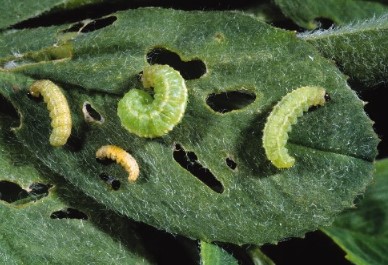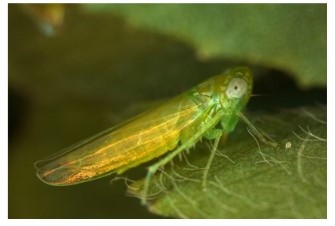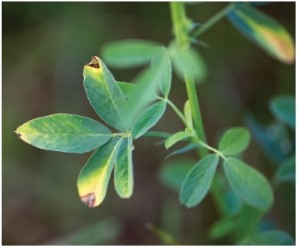By Anthony Hanson
Late-May and June is the time to begin scouting for insect problems in alfalfa. Primarily two insects can occasionally cause economic damage in Minnesota: alfalfa weevil in spring, and potato leafhopper throughout the growing season as population levels increase.
Alfalfa weevil
Alfalfa weevil is an early-season pest of alfalfa in Minnesota. Larvae are the most damaging stage that can skeletonize leaves where only leaf veins or holes remain (Fig. 1). Larvae are yellow to green color with a black head and a white stripe along their back. Often, growers become aware of the larvae when they find them on their mower during the first cutting of the year.
Scouting
Scouting should occur in mid-May through June by using a sweep net to determine if larvae are present. If present, select and cut 30 plants across the field at ground level. Record each plant’s height and shake in a 5-gallon bucket to determine average number of larvae per stem in the field and if weevil counts exceed economic thresholds (Table 1).

Figure 1. Alfalfa weevil larvae feeding.
Table 1. Economic thresholds for alfalfa weevil based on hay value.
| | Hay value ($/ton) |
|---|
| | Treatment | $50 | $75 | $100 | $125 | $150 | $175 |
|---|
| Stem height | cost/acre | Average larvae per stem |
|---|
10-15 inches
(mid-vegetative) | $7
$8
$9
$10
$11
$12 | 3.6
4.1
4.7
5.3
5.9
6.4 | 2.2
2.6
3.0
3.4
3.7
4.1 | 1.5
1.8
2.1
2.4
2.7
3.0 | 1.1
1.4
1.6
1.8
2.1
2.3 | 0.9
1.1
1.2
1.4
1.6
1.8 | 0.7
0.8
1.0
1.2
1.3
1.5 |
16-20 inches
(late vegetative) | $7
$8
$9
$10
$11
$12 | 3.8
4.4
4.9
5.5
6.1
6.7 | 2.4
2.8
3.2
3.6
4.0
4.4 | 1.8
2.1
2.4
2.6
2.9
3.2 | 1.4
1.6
1.8
2.1
2.3
2.5 | 1.1
1.3
1.5
1.7
1.9
2.1 | 0.9
1.1
1.2
1.4
1.6
1.7 |
>20 inches*
(early bud) | $7
$8
$9
$10
$11
$12 | 4.0
4.6
5.2
5.8
6.3
6.9 | 2.7
3.1
3.5
3.8
4.2
4.6 | 2.0
2.3
2.6
2.9
3.2
3.5 | 1.6
1.8
2.1
2.3
2.5
2.8 | 1.3
1.5
1.7
1.9
2.1
2.3 | 1.2
1.3
1.5
1.6
1.8
2.0 |
| *If >50% of plants are at bud stage, it's more beneficial to mow. |
Management
Insecticides labeled for alfalfa weevil include pyrethroids and organophosphates. Parasitoid wasps help suppress populations, but they are also susceptible to these insecticides. Practices that significantly reduce these parasitoid populations may cause flare-ups of alfalfa weevil in following years.
Most damage occurs before the first cutting in spring. Mowing and exposure from lack of cover kills most larvae, so early mowing can also control alfalfa weevil to some degree. Damage can still occur under windrows where larvae are protected if the hay cannot be baled shortly after mowing.
Insecticide treatment is typically not useful after the first cutting of the year as larvae develop in to adults in June. At this stage, they do not damage plants and will not lay additional eggs until the next spring.

Figure 2. Adult potato leafhopper.
Potato leafhopper
Potato leafhopper (PLH) is a migratory pest of alfalfa that overwinters near the Gulf of Mexico and migrates to Midwestern states in summer. It can be especially damaging on alfalfa, particularly near weedy areas where they can have higher population sizes.
Leafhoppers can sometimes be confused with other small soft-bodied insects such as aphids, but leafhoppers have elongate bodies and tend to be very mobile compared to aphids (Figure 2).
Leafhoppers are piercing-sucking insects that rupture plant tissues and disrupt nutrients. On alfalfa, PLH feeding produces a distinct yellow V-shape on leaf tips and plant stunting. First-year alfalfa can be especially susceptible to damage where yields can be significantly reduced.

Figure 3. "Hopper-burn" from feeding with
triangular yellowing on leaf tips.
Scouting
PLH scouting:
- Scout by sweep netting beginning in mid-June using a 15-inch diameter net.
- One 180° swing = one sweep. The net should swing through the whole plant, not just the top canopy.
- 10 sweeps at 5 locations in the field.
- Avoid windy wet conditions and field edges.
- Determine average # potato leafhoppers per sweep.
Treatment
If treatment is justified (Table 2), various pyrethroids and organophosphates are labeled for use on potato leafhopper.
Table 2. Economic threshold of average number of potato leafhopper per sweep when treatment is justified.
| Alfalfa | Cost of treatment per acre |
|---|
| height (in) | $10 | $12 | $14 | $16 | $18 |
|---|
| 4 | 0.2 | 0.3 | 0.4 | 0.5 | 0.6 |
6 | 0.3 | 0.5 | 0.6 | 0.8 | 0.9 |
| 8 | 0.4 | 0.6 | 0.8 | 1.0 | 1.2 |
| 10 | 0.5 | 0.8 | 1.0 | 1.3 | 1.5 |
| >10 | 1.0 | 1.6 | 2.0 | 2.6 | 3.0 |
Resistant varieties are available that can tolerate higher numbers of PLH. Economic thresholds in Table 2 should be multiplied by 10 to determine if treatment is needed on these tolerant varieties (e.g., hairy leaf type).
Source: umn.edu